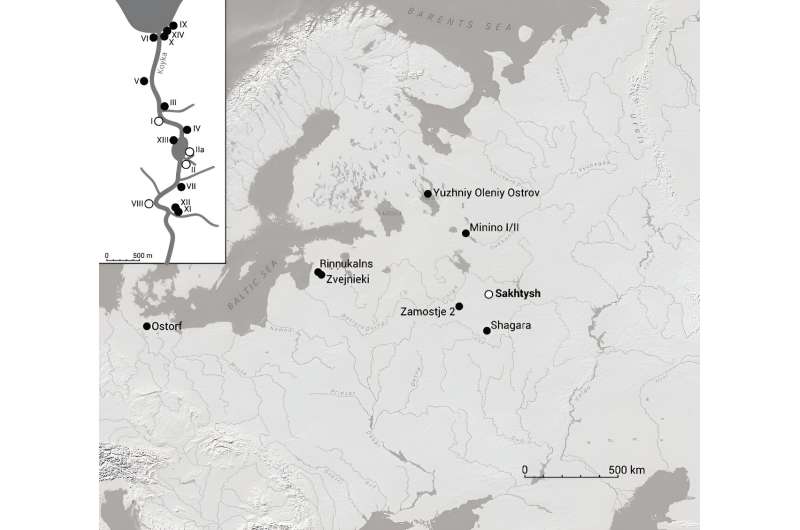This article has been reviewed according to Science X's editorial process and policies. Editors have highlighted the following attributes while ensuring the content's credibility:
fact-checked
proofread
New approach to carbon-14 dating corrects the age of a prehistoric burial site

How old are these bones? This standard question in archaeology can be answered quite precisely in many cases with the help of the carbon isotope 14C. But there are exceptions. Certain living habits, such as that of prehistoric hunter-gatherer-fisher communities, can distort 14C dating, because carbon in aquatic ecosystems typically contains less 14C than carbon from terrestrial plants and animals.
An international team led by researchers from the Leibniz-Zentrum für Archäologie (LEIZA), the ROOTS Cluster of Excellence and Kiel University (CAU) has now been able to date Neolithic graves at the important site of Sakhtysh (Russia) accurately for the first time, thereby identifying new patterns in the cultural development of the era.
"At the same time, the method used here also enables more precise dating of human remains in other regions with similar environmental conditions," says Dr. John Meadows. He is the lead author of the study, which has been published in Science Advances.
One of the largest known prehistoric burial sites in northeastern Europe
In Sakhtysh, about 200 kilometers northeast of Moscow, around 180 prehistoric burials were excavated between 1962 and 1992. Pottery remains show that they date from around 5000 to 3000 BC. This makes Sakhtysh one of the largest known burial sites from this period in northeastern Europe.
However, the exact dating of the individual burials and thus also their chronological order has so far remained uncertain. One of the reasons: The buried people ate a lot of fish during their lifetime.
"It is known that this diet reduces the ratio of carbon-14 to carbon-12 in the bones. As a result, the bones appear much too old. These shifts are, moreover, highly variable and have so far been difficult to correct," explains John Meadows, who conducts research at the Leibniz-Zentrum für Archäologie in Schleswig (LEIZA-ZBSA) and at Kiel University and is a member of the ROOTS network.
Carbon-14 dating is off by up to 900 years
The team of the current study compared isotope analyses on two samples of people who were excavated at Sakhtysh: one on a tooth and one on the petrous bone. The teeth and the petrous bone are the only mineralized parts of the human body that are not remodeled after they form, and they are formed at different ages.
"If diet changed during childhood and adolescence, the differences in isotope values between an individual's tooth and petrous bone allow us to draw conclusions about how much the 14C dating of the individual needs to be corrected," says Meadows.
A mathematical model of these differences indicated a shift of up to 900 years for some burials. The corrections lead to a completely new chronology of the burial site, which allows new interpretations of the cultural background. For example, an anomalous grave turned out to be the youngest, dating to the early 3rd millennium BCE. The oldest burials, on the other hand, date from the early 5th millennium BCE.
New chronology provides new insights into prehistoric communities
"When phased correctly, the graves show shifts in the trade networks, which tended to move from the east towards the Baltic region between 3500 and 3000 BCE. Another result of the investigations is that there is often more than one generation between individual burials, meaning that the burial site was only used sporadically over a long period of time," explains Anastasia Khramtsova from the Cluster of Excellence ROOTS.
"We can only interpret finds correctly if we can place them in the correct chronological order. Being able to work out environmental influences on 14C dating is therefore fundamental. If there are no terrestrial organic grave goods such as animal bones, our method can help to reduce corresponding uncertainties at other sites in the future," summarizes Meadows.
More information: John Meadows et al, Dietary 14 C reservoir effects and the chronology of prehistoric burials at Sakhtysh, central European Russia, Science Advances (2024). DOI: 10.1126/sciadv.adk2904
Provided by Leibniz-Zentrum für Archäologie


















